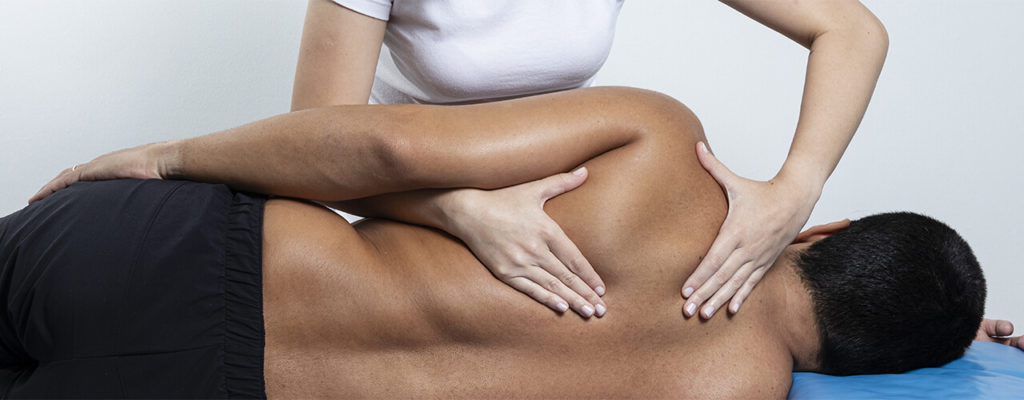Manual physical therapy – Manual therapy is machine-free or any electricity-based device-free physical therapy. It is done by physiotherapists or occupational therapists to relieve chronic pain conditions that occurred due to sports injury or any other musculoskeletal condition. The therapy used by physiotherapists mainly involves three approaches – soft tissue mobilization, joint mobilization, joint manipulation, by applying pressure with hands to the affected area.

Soft tissue mobilization is a type of massage which primarily focuses on soft tissues (muscles, connective tissues). A massage involves hand therapy/massage to treat the condition without any machines and therapy appliances.
These approaches are based on different grading scales. Each step involves the working of the therapy.
The definition of manual physical therapy from the International Federation of Orthopaedic Manipulative Physical Therapies: “Skilled hand movements intended to produce any or all of the following effects:
improve tissue extensibility; increase range of motion of the joint complex; mobilize or manipulate soft tissues and joints; induce relaxation; change muscle function; modulate pain; and reduce soft tissue swelling, inflammation or movement restriction.”
Manual therapy is also known as manipulation therapy. It is highly beneficial when combined with special therapeutic exercises. It works wonders for joint-specific pain which causes limited range of motion or
Techniques in Manual Therapy
There are quite a few techniques included in manual therapy. Let us have a glimpse.
- Massage: This is an integral part of manual therapy. In hand massage, pressure is applied to the muscles. This mainly works on the soft tissues of the body: muscles and fascia like tendons and ligaments. This technique improves the blood circulation to the injured part and relaxes muscle by easing the pain.
- Joint mobilization: this technique plays an important role in manual therapy. As the name suggests, it targets the mobility of joints restricted due to tight muscles around the joints. It basically works on measuring the range of motion of the affected joint from the initial level to the end level. Joint Mobilization involves the passive movement of specific joints using the skilled application of force, direction, and technique. The motion range is divided into five grades. Given below is the classification of the ‘grade of motion’ –
GRADE I – initial range of motion at small amplitude
GRADE II – active intermediate range of motion at large amplitude
GRADE III – end range of motion at large amplitude
GRADE IV – very end range of motion into joint play at small amplitude
GRADE V – at this grade end of the joint play has been reached with low amplitude and fast thrust.
This grading is from Maitland Joint Mobilization. This grading is widely used by most therapists. Another grading is also available which is from Kaltenborn Traction Grading Scale. The working of this scale is first neutralizing the pressure on joints, then passing play within the joint capsule and lastly having a good stretching of the tissue surrounding the affected joint.
- Joint manipulation: it is an art of regaining joint mobility by using quick-thrust techniques in the movements. It is basically GRADE V of the joint mobilization, low amplitude and high speed.
How does it work?
Manual therapy is a treatment offered to patients suffering from sports/ musculoskeletal injury. It is mainly applied when an impairment occurs to joint, restricted and shortened muscles.
Techniques involved in manual therapy aim to relieve pain caused by the above-mentioned conditions. The approach towards condition helps to restore the natural ability of joints to function in a proper manner without any discomfort.
Physical therapists use joint mobilization and manipulation, a complement of each other, to resolve various conditions. Where joint mobilization is a very detailed process, joint manipulation works by a single force quick movement to promote mobility.
What conditions can be cured by manual therapy?
Many muscles and joint-related problems can be treated successfully with manual therapy. These problems may be a result of extensive exercise, using wrong gears and sudden jerks and movements during sports and athletic activities. These conditions can result in severe pain and motion impairment or temporary handicap.
Manual therapy has proved a panacea for some of the conditions. Let’s have a look-
- Muscle strain or sprain
- spinal and shoulder pain
- Head pain
- Arthritis pain
- Knee pain
- Orthopaedic conditions
- Migraines
Who can perform Manual Therapy?
A physical therapist with a high school degree can perform manual therapy. But he is not an expert at his work because physical therapy is a broad field and manual therapy is a part of that field. For an exceptional manual therapist, some specializations are also required to learn the techniques applied in manual therapy.
Manual therapy skills can be further boosted by the Clinical Certification in Orthopedic Manual Therapy [COMT]. This program aims to scientifically teach soft tissue mobilization, joint mobilization and manipulation techniques, which is the pillar of Manual Therapy.
This gives flexibility and practicality to the therapist to analyze each patient’s condition.
If you are suffering from any kind of pain or musculoskeletal problem, you should contact a certified and experienced manual therapy physical therapist. The physical/manual therapist will not only treat your condition but also prevents you from further damages and injury by giving proper guidelines.
